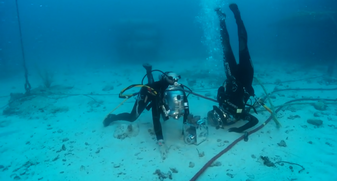Using cutting edge technology not really meant for the ocean was tricky! I'm the one filming upside down. It was easier to see the screen that way (and oddly comfortable underwater). Our photography will be featured in an art exhibit at MIT.

 Bringing the camera close to a mantis shrimp in the sand while filming with the Edgertronic camera.
Bringing the camera close to a mantis shrimp in the sand while filming with the Edgertronic camera. "Thanks to a couple of engineers at MIT, we were able to use a prototype camera called the Edgertronic to capture slow-motion video... And that particular camera gives us an insight into what fairly common animals do but we can't even see it in the blink of an eye. ... It gives us an insight into some of the animals that we were sitting right next to for 31 days and never normally would have paid attention to, such as hermit crabs."
"Using a cutting-edge piece of technology that's not really meant for the oceans is not always easy. We sometimes had to put the camera upside down, cordon it back to the lab, and actually man the trigger from the lab itself. But what this gives us is the foresight to look at and analyze in scientific and engineering terms some of the most amazing behavior that the human eye just can't pick up, such as this manta shrimp trying to catch its prey, within about .3 seconds. That punch is as strong as a .22 caliber bullet, and if you ever try to catch a bullet in mid-flight with your eye, impossible. But now we can see things such as these Christmas tree worms pulling in and fanning out in a way that the eye just can't capture, or in this case, a fish throwing up grains of sand. This is an actual sailfin goby, and if you look at it in real time, it actually doesn't even show its fanning motion because it's so quick."
"Using a cutting-edge piece of technology that's not really meant for the oceans is not always easy. We sometimes had to put the camera upside down, cordon it back to the lab, and actually man the trigger from the lab itself. But what this gives us is the foresight to look at and analyze in scientific and engineering terms some of the most amazing behavior that the human eye just can't pick up, such as this manta shrimp trying to catch its prey, within about .3 seconds. That punch is as strong as a .22 caliber bullet, and if you ever try to catch a bullet in mid-flight with your eye, impossible. But now we can see things such as these Christmas tree worms pulling in and fanning out in a way that the eye just can't capture, or in this case, a fish throwing up grains of sand. This is an actual sailfin goby, and if you look at it in real time, it actually doesn't even show its fanning motion because it's so quick."
"What I learned from spending 31 days underwater" was the title of Fabien Cousteau's TED talk this month in Rio de Janeiro about Mission 31. My focus on the mission, high speed filming with the Edgertronic camera, is featured from 7:00-9:04. Click here to watch!

From the transcript:
Fabien summarizes the mission's goals and accomplishments, and stresses the need for further exploration of the oceans.
For more info, check out my previous posts about working with the Edgertronic.
For more info, check out my previous posts about working with the Edgertronic.
AND, Photo Art EXHIBIT OPENING SOON!
I'm also excited to say my KickStarter campaign to fund an exhibit of the underwater slow motion photography we shot on the Edgertronic from Mission 31 was a great success! Those near Boston are welcome to attend the opening on the evening of January 4th in MIT's Wiesner Art Gallery. Just shoot me a message for the details.


 RSS Feed
RSS Feed
